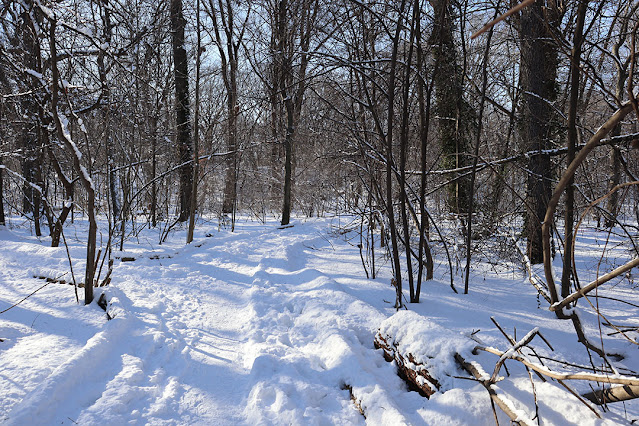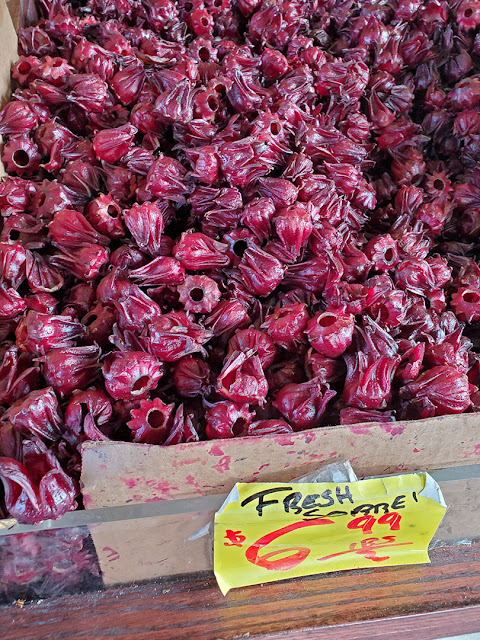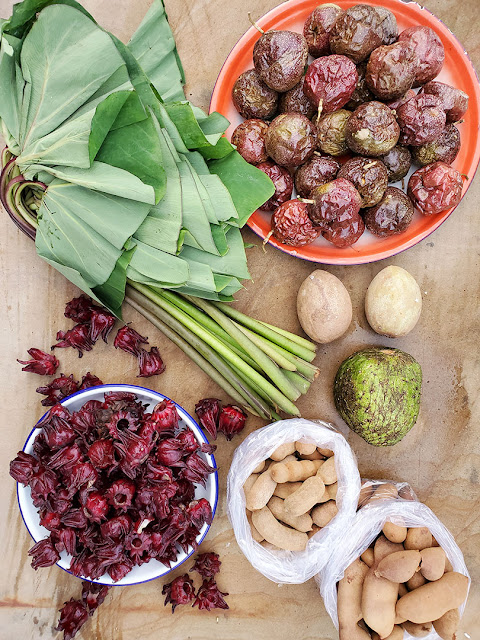I've been traveling. In the last couple of snowy months, I have visited the tropics. Twice. To get there, I traverse Siberia. Sort of.
At the end of a two mile hike straight across Prospect Park, I reach Grenada. On my way there my basket is empty. Heading back, boots squeaking in the freeze underfoot, it is brimming with fruit from the Caribbean. I need huskies.
It began in December, with a thoughtful gift of grenadillas and an unfamiliar canistel (Pouteria campechiana - above) from my friend Hannah Goldberg. She bought them at Labay Market, a West Indian grocery store in Brooklyn's Prospect-Lefferts neighborhood, on the east side of Prospect Park. Hannah is a regular, often in search of good things for her catering company Tanabel Table.
So I had to go. After a quick look at Google Maps walking made the most sense, because snowdrift parking is not much fun in this city. And a four mile hike is decent exercise (cardio-with-a-reward).
I went this way.
And down there.
And landed up here.
The corner store is lined with bins that spill produce flown in from the Dominican Republic and Grenada. And so I met sour, fresh roselle for the first time. It has numerous common names and may be best known simply as hibiscus; it is not the flower, but the calyx of a hibiscus species that actually resembles okra, in terms of its blooms. Its botanical name doesn't mess about: Hibiscus sabdariffa var. sabdariffa race ruber. I made a fermented syrup from them and they candied as they fermented.
Not plantains, or bananas. But you can have as many green coconuts as you like chopped open for you on the sidewalk.
The owner, McDonald Romain (who goes by Big Mac) presides inside behind a slipping facemask and a clear-ish MacGyvered COVID screen between his cash register and his customers. He takes his time to chat with each person as they pay, over the thumping sounds of loud Christian music (his Facebook page explains that he is "covered in the blood from head to toe"). And he grills me about what I plan to do with his produce, giving instruction, when necessary.
Once you squeeze past the counter (it's not a large store, and I am double-masked indoors, these days) you reach a jumbled motherlode of seasonally changing fruits and vegetables that are rare-to-non-existent in supermarkets: squat bananas, unripe, fat plantain, grenadillas, mamey apple, breadfruit, soursop, real Key limes, sour and sweet fresh tamarind, and, most recently, black sapote. In an open refrigerator are bags of frozen, peeled sugar cane, and elegant bundles of fresh taro leaves. Shelves are lined with West Indian delicacies and staples like canned callaloo, sacks of brown sugar, bags of mace. On ice at the back is a collection of whole, fresh fish. There is a kitchen too, but I have not seen it in action.
And so I come home with loot. It is urban foraging at its happiest.
The black sapote (a.k.a. chocolate pudding fruit) is the large green, round one, above. Amazingly, to me, it is closely related to persimmons: It is Diosypros nigra; Asian persimmons are Diospyros kaki, and the little native American persimmons are D. virginiana.
Big Mac suggested I would soon be back for the chocolate pudding fruit, but its thick creaminess and bland sweetness didn't thrill me. Possibly it was picked too early, someone suggested (when I posted it to Instagram) - it has many passionate supporters.
But I will be back for the taro. I prepared the large leaves first in a Jamaican curry, and then in a non-traditional Hawaiian lau lau - packages of pork belly wrapped in the leaves and steamed slowly (taro must be cooked for a long time to destroy the calcium oxalate crystals that otherwise irritate your tongue and mouth; this is not a green to blanch and eat vividly green).
The leaves have a delicious and distinctive flavor, and a silky, melting texture, once cooked. My lau lau also featured fresh ginger, because Labay's is the nicest I have ever eaten, it cooks till tender and chewable, as well as good Japanese soy (Ohsawa nama shoyu, from Gold Mine Natural Food Company).
Spring will come. But this is not a bad way to spend winter.
_________
Find me daily @66squarefeet on Instagram










I grow many of those fruits in my Zone 10a residential edible landscape here in SW Florida. Black Sapote needs to sit on your counter until it is actually oozing and looks spoiled for it to be totally ripe. I know that sounds weird, but it is so. I am growing many things that I have not yet prepared yet like taro. I also grow the cranberry hibiscus and it pops up all the yard. I am continually pulling it out where it is not wanted. It is so fun to walk around my yard and explore all the bounty!
ReplyDeleteOh my gosh, I am so glad I just recently found you. I have always, always wanted to live in New York City and it was not attainable, unfortunately. But reading your blog and seeing all the neat stuff you get to do is so neat. I can transport myself a little bit into the life I wished for. I would love to be you, but it's sorta, kinda nice to follow you and think about what could have been. I hope you love your life there.
ReplyDeleteThis comment has been removed by a blog administrator.
ReplyDelete